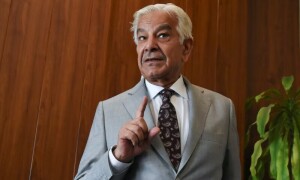KARACHI: If only regret could alter the course of life, 34-year-old Sultan would have counted himself as the most fortunate person in the world. Lying on a hospital bed with a stitched up neck following a surgery for oral cancer, he is unable to talk properly. But, his eyes reflect his grief and they brim with tears, if someone refers to his past and asks whether he would commit the same mistake again.
“My cousin was warned by a doctor to stop eating gutka and other hazardous concoctions some eight years ago after he developed difficulty in chewing and swallowing. He left it all, but continued with naswar,” Majid, Sultan’s attendant at the Jinnah Postgraduate Medical Centre’s Ward-15, told Dawn.
There are at least three other patients in the ward, who have either undergone surgery for oral cancer or await the procedure for similar reasons.
In the adjacent female ward, 28-year-old Muslima, mother of four and resident of Ibrahim Hyderi, is recovering after parts of her tongue and left cheek affected by cancerous growth were removed. She is visibly in distress.
“She is crying because her children and husband haven’t visited her since she got admitted to the hospital 10 days back,” her mother sitting on the bedside explained.
Experts say the disease is fast spreading in younger people
Upon inquiry, she said that her daughter had been hooked to gutka and betel quid (paan) for many years, which doctors believed to have caused the disease.
Doctors at the JPMC explained that 90 per cent of the oral cancer cases the hospital received involved the consumption of betel quid, areca nut (chaalia), gutka, mainpuri and other concoctions. Others are linked to smoking, alcohol use and human papillomavirus infection.
The hospital — the second facility in the whole province to have a radiotherapy unit (a must-facility to treat patients with advanced stage cancer) — receives 10 to 12 new cases of oral cancer every month.
“Cases of early-stage cancer are few in the public sector and most cases require the use of radiotherapy and chemotherapy,” said ENT specialist Prof Tariq Rafi, who is also the vice chancellor of the Jinnah Sindh Medical University.
He recently retired as head of the JPMC’s ENT department.
According to him, the most horrifying aspect now is to see the disease in younger age group, which was earlier found in patients above 50 years of age.
“We are seeing oral cancer patients as young as 18 years. Now that’s a very productive age; it means that the disease is having a huge impact on society in terms of contributing to the health burden, loss of productivity as well as affecting individual families,” he said, worryingly.
Cancers grow and spread fast in young patients, he said, blaming the situation on the “emergence of highly carcinogenic products like gutka and mainpuri, etc”.
Consumption of such products has an adverse impact on pregnancy as well.
“Patients with advanced stage oral cancer have a challenging life after surgery as parts affected by cancer are removed. They may develop difficulty in breathing, eating and swallowing, apart from experiencing the painful side effects of radiotherapy and chemotherapy,” he said.
Challenges in treatment
While burden of oral cancer patients has dramatically increased, treatment facilities are limited in the province. The situation is resulting in a loss of quality treatment, long waiting lists, delays in surgery as well as affecting the timely treatment of other patients.
“Ideally, a patient should have undergone radiotherapy within a month but the patients here get it in three months, reducing its effectiveness. After JPMC, the Karachi Institute of Radiotherapy and Nuclear Medicine is the second facility to offer radiotherapy in the province. Radiotherapy in the private sector is very costly,” Prof Rafi said.
Prof Iqbal Mohammad Khyani, head of ENT Unit II at the Civil Hospital Karachi, said that of the 250 to 300 patients who reported at the outpatient department, 30pc had complaints involving betel quid, areca nut and other concoctions.
“Of these, 12 to 15 cases have pre-malignant conditions. The difference of male and female is getting less pronounced,” he said, adding that the majority of patients are poor and had low nutritional status.
He agreed with Prof Rafi that most patients reported late and wasted a lot of time by remaining in a denial phase during which they turned to alternative treatment or faith healers.
Treatment, however, was successful only if the lesion was diagnosed early.
“The relapse rate is high in the public sector because of multiple factors including compromised treatment due to high patient burden. In advanced stage cases, 70pc cases lead to relapse and result in death,” he said.
Dr Muhammad Fareeduddin at the Indus Hospital shared his concern over consumption of the hazardous chewable products by children.
He said: “We off and on receive children in emergency condition after chaalia gets stuck in their throat and there have been cases in which the patient couldn’t survive.”
Toxic metals
There have been numerous studies attributing the incidence of head and neck cancers to consumption of betel leaf, areca nut, tobacco and their various concoctions such as gutka and mainpuri.
While there is no registry in the country to record cancer cases, Karachi was suggested to have the highest incidence of oral cancer in the world. This was proved by late Dr Yasmin Bhurgri of the Aga Khan University Hospital through her extensive studies, one of which was published in 2005.
A detailed study conducted by the Pakistan Council of Scientific and Industrial Research in 2010 found high levels of trace and toxic metals in these chewable products.
Toxic metals, according to experts, can directly or indirectly damage the DNA, which increases the risk of cancer. Heavy metals disrupt metabolic functions and displace the nutritional minerals vital for biological function.
Advocate Muzammil Mumtaz Meo has been fighting a legal battle for eradication of the menace of gutka, mainpuri, etc.
“There is no law [to deal with] this hazardous business,” he said. “There is a need to register cases under sections which are non-bailable and award harsher punishments.”
He alleged that a “gutka mafia” was operating in every neighbourhood of the city with police patronage.
Published in Dawn, November 5th, 2017












































